Quick Overview: This guide explores AI app development as the foundation for modern business innovation. From planning and design to deployment and monitoring, you’ll learn industry use cases, cost factors, timelines, and challenges. Discover proven strategies, tools, and insights to build AI apps that drive measurable growth.
If you are here, you are already exploring how AI can shape the future of your business. Expectations from stakeholders keep growing, and you feel the pressure to deliver results that go beyond experiments.
The market numbers confirm this urgency. In 2024, AI app development generated USD 40.3 Billion, and it is forecast to reach USD 221.9 Billion by 2034 with an 18.60 percent CAGR. North America alone holds 38 percent of this revenue, equal to USD 15.31 Billion. These figures show that competitors are already investing, and you cannot afford to stand still. (Source – market us)

But entering this space without clarity brings risk. If your goals remain vague, compliance is overlooked, or the wrong partner is chosen, your project will drain budgets without creating value.
This guide gives you a structured roadmap for AI app development, helping you plan, budget, and execute with confidence.
Let’s move ahead and explore what AI app development means for your business in 2026 and beyond.
What is AI App Development in 2026?
AI app development in 2026 means building software that integrates artificial intelligence to solve business problems. It goes beyond automation, using data-driven models to deliver predictions, personalization, insights, and decisions that improve user experiences and drive measurable outcomes.
When you build an AI-powered application today, you are not simply adding features. You are enabling your system to learn from data, adapt to new information, and provide smarter outputs over time. The ability to learn from data and adapt is what separates traditional applications from modern AI-driven solutions.
For example, predictive models can help retail businesses forecast demand, while generative models can create personalized customer interactions. In finance, AI in app development can reduce risks by analyzing patterns of fraud. In healthcare, AI mobile app development can assist with faster diagnostics.
Unlike earlier years, AI in mobile application development now combines on-device intelligence and cloud-based models, giving you both speed and security. With the right approach, AI app development opens opportunities for efficiency, engagement, and innovation across industries.
Keeping up with emerging AI trends ensures businesses make the right technology and investment choices.

Key Types of AI App Development and What They Mean for Your Business
AI apps in 2026 include machine learning applications, natural language processing tools, computer vision systems, and generative AI solutions. These applications can run on-device, in the cloud, or through hybrid models depending on performance needs, privacy requirements, and industry regulations.
When you explore AI app development, it is important to understand the main types of applications available. Each type has unique strengths, and the right choice depends on your goals, data, and the challenges your business needs to solve.
1. Machine Learning (ML)-Based Apps
Machine learning apps focus on analyzing data to find patterns and make predictions. A retailer can use them to forecast seasonal demand, while banks can apply them for risk scoring. Over time, these apps continue improving as they process more information, which makes predictions more accurate and valuable.
2. Natural Language Processing (NLP) Apps
NLP apps allow systems to understand and generate human language. Enterprises use them for chatbots, compliance automation, and multilingual support. This reduces manual workload while improving customer engagement. Clear governance ensures sensitive communication remains safe. Many leaders see AI in app development as the path to better conversations and faster resolutions.
3. Computer Vision Apps
Computer vision apps allow machines to interpret visual information such as photos or video streams. Manufacturers apply them for quality checks on production lines, while healthcare teams use them for analyzing medical images. These solutions turn visual data into actionable insights, supporting faster and more reliable decisions in daily operations.
4. Generative AI Apps
Generative AI applications create new content such as text, images, designs, or even source code. Marketing teams can use them for personalized campaigns, while product design teams can speed up prototyping. These apps expand creative capacity and help businesses cut development timelines.
5. Deployment Models of AI Apps
On-Device AI Apps
On-device apps provide fast responses and privacy since data stays local. Cloud apps support bigger models and complex workloads that need more power. Hybrid models balance both, keeping sensitive data on device while scaling complex tasks in the cloud. Many teams adopt AI in mobile application development when low latency and local controls matter most.
Cloud AI Apps
Cloud-based AI applications operate on remote servers with large computing capacity. They are ideal for complex workloads and big data processing. They depend on stable internet connections and create ongoing infrastructure costs that must be planned in advance.
Hybrid AI Apps
Hybrid applications combine local and cloud resources. Sensitive data can stay on the device, while demanding tasks run on cloud servers. This model balances privacy, performance, and scalability, making it popular among enterprises with strict compliance needs.
Different types of AI apps, from ML and NLP to vision and generative, solve distinct business needs. Deployment choices like on-device, cloud, or hybrid further shape performance, privacy, and cost outcomes. Picking the wrong mix often leads to wasted budgets and weak adoption.
Exploring proven AI business ideas alongside deployment strategies helps you align the right AI app type with the right model, maximizing value and reducing risks.
What Are the Top Industry Use Cases of AI App Development?
AI app development supports industries including finance, healthcare, logistics, eCommerce, insurance, travel, fitness, food delivery, and wealth management. Businesses use these solutions to automate decisions, improve personalization, detect risks, and deliver faster, smarter services that increase revenue and customer trust.
Exploring practical AI use cases in these sectors shows how enterprises can gain measurable advantages and stay competitive.
AI in Fintech Industry
Fintech companies use AI apps for fraud detection, credit scoring, and predictive analytics. You can reduce risks by identifying unusual patterns in real time. The growing use of AI in the fintech industry has made personalized financial recommendations more accurate, improving customer engagement and building stronger trust across digital platforms.
AI in Banking
Banks face growing pressure from regulators and customers alike. Through the adoption of AI in banking, institutions can automate compliance checks, monitor suspicious transactions, and simplify onboarding. Chatbots improve service by resolving routine queries instantly.
Together, these solutions raise efficiency and reduce risks. With artificial intelligence app development, banks embed compliance into workflows while creating faster, more secure customer experiences.
Artificial Intelligence in Healthcare
Healthcare apps apply AI to medical imaging, diagnosis, and treatment planning. The growing adoption of artificial intelligence in healthcare helps providers detect conditions earlier and improve patient outcomes. AI also powers virtual health assistants that support patients with reminders, follow-ups, and real-time symptom analysis.
AI in Logistics
Logistics companies benefit from AI apps that optimize routes, predict delivery delays, and manage inventory. The use of AI in logistics enables smarter forecasting, allowing businesses to predict demand accurately and adjust supply chains in advance. AI-driven systems lower costs, reduce fuel usage, and improve customer satisfaction.
AI in eCommerce
Ecommerce businesses apply AI to product recommendations, dynamic pricing, and customer service. The growing use of AI in eCommerce allows brands to predict customer preferences and personalize every interaction. Intelligent recommendation engines increase sales by showing customers items they are more likely to buy. AI chatbots and virtual assistants improve response times and create smoother shopping journeys.
AI in Insurance Industry
Insurance firms handle vast amounts of risk data and claims. The adoption of AI in insurance industry practices enables faster claim approvals, fraud detection, and precise underwriting. Customers benefit from quick resolutions, while insurers maintain accuracy and limit losses. These results highlight the value of AI mobile app development in building trust and operational efficiency.
AI in Travel
AI supports travel apps by personalizing itineraries, managing bookings, and automating support. The use of AI in travel helps businesses deliver more tailored experiences by predicting traveler preferences and simplifying complex journeys. Artificial intelligence chatbots answer queries in real time, while translation tools and recommendation systems make trips easier, safer, and more enjoyable for global travelers.
AI in Fitness Industry
AI powers fitness apps that adapt workouts, track diet habits, and deliver real-time coaching. The rise of AI in fitness industry applications helps brands create hyper-personalized health experiences that keep users motivated. Users enjoy plans tailored to their progress and goals. Businesses retain customers by offering personal engagement at scale. This trend illustrates the growing demand for AI in mobile application development in consumer wellness.
AI in Food Delivery Apps
Food delivery platforms benefit from AI in food delivery apps for smarter demand forecasting, delivery route planning, and personalized offers. These AI-driven insights help predict peak times and allocate resources more efficiently. Customers receive quicker deliveries, while restaurants increase sales through optimized promotions and improved operational control.
AI in Wealth Management
Wealth managers use AI in wealth management to build robo-advisors, optimize portfolios, and improve risk modeling. These intelligent systems help clients receive timely, personalized advice aligned with market conditions. Advisors extend services to larger audiences without losing transparency or compliance. Success here depends on how to develop AI based app strategies that scale responsibly.
AI in Stock Trading
Stock trading apps powered by AI in stock trading use real-time analytics, automated trades, and advanced risk control. Predictive models help investors make faster, data-driven decisions with greater confidence. With AI app development, trading platforms gain accuracy and speed, both essential for competitive financial markets.
Across industries, AI app development is solving real problems such as fraud detection in finance, early diagnosis in healthcare, smarter routing in logistics, and personalization in eCommerce. These applications improve efficiency, reduce costs, and create better customer experiences at scale.
The variety of use cases shows that AI is not limited to one sector but is becoming a foundation across business functions. Enterprises that move early capture stronger market positions, while those who delay risk falling behind competitors already adopting a generative AI solution or other advanced technologies.
How Should You Plan and Ideate for AI App Development?
Planning and ideation align business outcomes, validate feasibility, confirm data access, and define compliance boundaries. This stage produces measurable goals, a realistic scope, and governance guardrails. Strong planning reduces rework, de-risks delivery, and sets clear expectations before design, model selection, and build.
Define the outcome hypothesis and North Star metric
State the problem, the audience, and the single metric that proves success. Capture baseline and target in writing. List assumptions and risks beside each target so leaders know what must be true to win.
Map ideas with a Business Impact × Data Readiness matrix
Score ideas on projected value, effort, and ethical exposure. Rank opportunities that pair high impact with ready data. Use a decision log so tradeoffs stay visible and agreed. This discipline keeps AI app development focused and measurable.
Create a data contract and access plan
Name sources, owners, schemas, SLAs, retention, and lineage. Document PII fields, masking rules, and approved uses. Specify who can read, write, and approve changes. Lock this in before budgets, so scope reflects real data limits.
Choose architecture and integrations
Pick on device, cloud, or hybrid based on latency, privacy, and cost. Define integration points, event flows, and storage patterns. Select observability, feature stores, and CI pipelines that your teams can operate with confidence.
Set model strategy and evaluation
Choose a model path that fits goals and data. Use proven baselines, then evaluate against clear metrics and guardrails. Document evaluation datasets, thresholds, and fallback behavior for tough cases.
Build features and integrate safely
Implement the smallest slice that proves value. Wire features behind flags and add rollback plans. Keep security reviews and access audits inside the development rhythm.
Test, safety, compliance, and readiness
Test reliability, latency, and cost under real traffic patterns for AI in app development. Run safety reviews for privacy, bias, and prompt misuse. Capture audit trails and approvals to satisfy regulators and customers.
Deploy, monitor, and improve
Release in phases with canaries and quick rollback. Monitor outputs, user outcomes, costs, and drift in one dashboard. Schedule model and prompt reviews to keep results aligned with business goals.
Strong planning and ideation connect business outcomes with realistic execution. They define data boundaries, model strategies, compliance rules, and monitoring practices that reduce risk. Using an AI app development platform within this stage ensures clarity before teams commit budget, design, and build.
When planning is done right, AI app development moves with less friction, faster timelines, and outcomes that stakeholders can trust.
What Is the Role of Technology and Architecture in AI App Development?
Technology and architecture in AI app development define how models, frameworks, and infrastructure combine to deliver reliable, scalable, and secure solutions. These decisions determine performance, compliance, and long-term ROI for businesses adopting AI-driven applications at enterprise scale.
Pre-trained vs Custom Models
Enterprises must decide whether to adopt ready-made AI models or invest in building their own. This choice impacts cost, speed, accuracy, and long-term control. Understanding both options helps businesses select the approach that best matches their goals.
- Pre-trained Models: These are built on large public datasets and are ready to deploy quickly. They reduce costs, shorten time to market, and work well for standard use cases like image recognition or language translation. The trade-off is less flexibility, since the model wasn’t designed for your exact business context.
- Custom Models: These require more investment in data, talent, and infrastructure, but they deliver precision tailored to your industry and workflows. They’re best when unique compliance needs, proprietary data, or domain-specific accuracy are critical for success.
Many enterprises choose a hybrid path: starting with pre-trained models for speed, then fine-tuning them with proprietary datasets. This approach blends affordability with accuracy and creates long-term control without slowing initial deployment. It has become especially effective in AI in mobile application development, where balancing speed, accuracy, and resource limits is essential.
Frameworks and Tools
The right framework accelerates delivery and simplifies scaling, but the wrong choice can lock teams into rigid stacks. Leaders should evaluate support, licensing, and community maturity before committing. These factors decide whether an AI project grows smoothly or stalls early.
- TensorFlow: Backed by Google, TensorFlow supports large-scale training, production deployment, and cross-platform compatibility. It’s a strong choice for enterprises that need robust ecosystems, community support, and integration with cloud services.
- PyTorch: Popular in research and enterprise settings, PyTorch offers flexibility, dynamic computation graphs, and faster prototyping. It’s widely adopted for innovation-heavy projects that demand experimentation and scalability.
- Core ML: Built by Apple, Core ML enables AI capabilities directly inside iOS and macOS apps. It’s the go-to for companies focused on mobile-first strategies and delivering on-device intelligence with speed and privacy.
- Hugging Face: Known for pre-trained models and easy-to-use APIs, Hugging Face simplifies NLP, computer vision, and generative AI projects. It reduces setup time while giving access to cutting-edge open-source models that accelerate innovation.
Decision-makers should choose frameworks based on team expertise, compliance obligations, and future scalability, not just popularity. Making the wrong choice can create costly rework and slow down AI adoption at scale.
Infrastructure Options
Infrastructure plays a central role in AI app development, shaping performance, scalability, and security. The choice between cloud, edge, and hybrid environments determines how data is processed and how effectively applications meet business and compliance needs.
- Cloud Infrastructure: Cloud platforms deliver high scalability and strong computing resources. They are effective for enterprises managing large datasets, advanced model training, or global deployments. The drawback lies in recurring operational costs and vendor dependency.
- Edge Infrastructure: Edge solutions process data locally on devices or IoT hardware. They focus on privacy and real-time response, which makes them useful in sectors like healthcare, finance, and logistics where speed and security cannot be compromised.
- Hybrid Infrastructure: Hybrid models combine both approaches, keeping sensitive information on the device while shifting demanding tasks to the cloud. This balance of compliance, performance, and cost is especially valuable in AI mobile app development, where quick responses and data privacy are equally important.
Security, Compliance, and Monitoring
Enterprises cannot treat security and compliance as afterthoughts in AI initiatives. Every architecture must account for encryption, access control, and privacy from the very beginning. Regulatory frameworks such as GDPR or HIPAA demand audit trails, clear accountability, and explainable outputs.
Continuous monitoring is equally important. Systems should detect model drift, bias, or misuse in real time and trigger alerts before they affect customers. Transparent logging and approval workflows help satisfy regulators and protect reputations.
Treating these safeguards as core design principles makes solutions more resilient and trustworthy. Strong governance transforms artificial intelligence app development from a technical project into a long-term, business-ready capability.
Technology and architecture decisions shape how effectively AI apps deliver on business goals. Model selection, framework choice, infrastructure design, and governance all influence cost, performance, and compliance. Enterprises that align these elements early reduce risks and accelerate adoption when they plan to integrate AI into an app for real-world use.
A well-planned technology and architecture strategy in AI app development creates reliable, scalable, and future-ready solutions.
How Should You Approach Design and Prototyping in AI App Development?
Design and prototyping in AI app development focus on creating intuitive user experiences and testing product ideas quickly. UX ensures AI interactions feel natural, while prototyping validates features, functionality, and feasibility before heavy investments in development and deployment.
UX for AI Apps
User experience for AI apps goes beyond aesthetics. Interfaces must explain predictions, show confidence levels, and provide clear fallback options when AI is uncertain. Transparency builds trust, while simple design prevents cognitive overload.
Personalization should be balanced with privacy, ensuring users feel in control. A strong UX foundation is essential in AI mobile app development, helping AI features support, not frustrate, the customer journey.
Prototyping Strategies
Prototyping reduces risk by validating ideas early. Clickable wireframes, low-code mockups, and simulation environments test usability and gather stakeholder feedback without expensive builds. Teams should start small, proving one high-impact use case at a time. This approach shortens timelines, exposes gaps, and sets realistic expectations for investment.
Prototyping is also a way to test compliance guardrails before scaling to production, making it a vital step for enterprises adopting AI in app development.
Design and prototyping ensure that AI solutions are usable, explainable, and aligned with business goals before full development begins. Whether it’s a predictive model or a generative AI solution, these practices create clarity, reduce wasted effort, and strengthen trust in outcomes.
Strong design and prototyping practices in AI app development make the difference between adoption and abandonment.
How to Develop and Integrate AI Apps Successfully: Backend, Frontend, and API Integration
Development in AI app development involves backend logic, frontend design, and API integration. Backend manages data and models, frontend shapes user experience, and APIs connect systems.
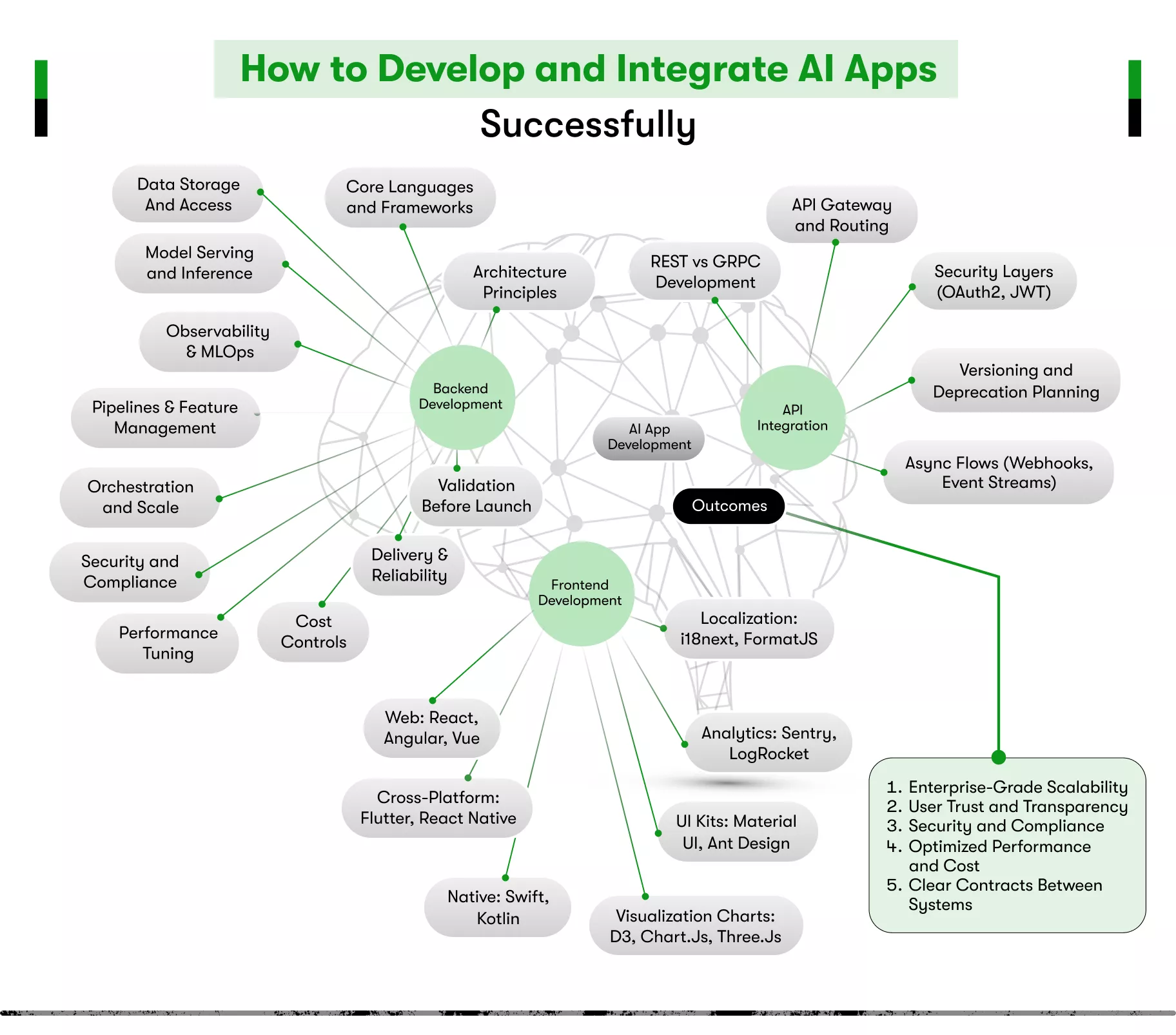
Together, they ensure smooth performance, scalability, and reliability, turning raw AI models into real-world enterprise-grade applications.
Backend Development for AI App Development
The backend is the engine of your AI product. It moves data, runs models, and exposes secure APIs. It must be modular, observable, and easy to scale. Treat it like a product, not a script.
Architecture principles
Design small, focused services. Define clear ownership and SLAs. Keep compute stateless. Store state in durable systems. Isolate model serving from business logic. Add queues to absorb spikes. Use idempotent APIs so repeated calls don’t create errors, and version every contract to keep integrations stable.
Core languages and web frameworks
Pick tools your team can run well.
- Python with FastAPI, Flask, or Django for APIs and orchestration.
- Node.js/TypeScript with Express or NestJS for high-throughput services.
- Java/Kotlin with Spring Boot for strict enterprise needs.
- Go for low-latency services and simple concurrency.
APIs and integration patterns
Design clean, stable contracts. Use REST for broad reach. Use gRPC for low latency. Add API Gateway or Kong for routing and quotas. Secure with OAuth2 or JWT. Support pagination, retries, and timeouts. Add webhooks or event streams for async flows. Version your APIs. Never break clients without a deprecation plan.
Data storage and access
Match stores to workloads.
- OLTP: PostgreSQL or MySQL for transactions.
- Caching: Redis for hot data and rate control.
- Analytics: BigQuery, Snowflake, or Redshift for reporting.
- Search: Elasticsearch or OpenSearch.
- Vector search: Pinecone, Weaviate, Milvus, or pgvector for embeddings.
Define data contracts and schemas. Teams should track data lineage to ensure every feature and model input can be traced back to its source, which strengthens accountability and compliance. Enforce row-level access where needed.
Model serving and inference
Separate serving from app code. Expose models through gRPC or REST.
- Servers: TensorFlow Serving, TorchServe, NVIDIA Triton, ONNX Runtime, or OpenVINO.
- Real-time: use autoscaled pods behind a load balancer.
- Batch: Spark or Ray for offline scoring.
Enterprises should version every model and maintain a central registry. This ensures teams can track changes, roll back safely, and meet compliance requirements for audit and accountability.
Pipelines and feature management
Build repeatable flows for data and features.
- Orchestration: Airflow or Prefect.
- Transformations: dbt for SQL-based models.
- Feature store: Feast for online and offline parity.
Validate freshness, completeness, and drift on every run. Fail fast on bad data. Alert owners.
Orchestration and scale
Package services in Docker. Deploy to Kubernetes. Use KServe or Seldon Core for model lifecycles. Add Horizontal Pod Autoscaling. Use Kafka or RabbitMQ for backpressure. Keep configs in the environment. Store secrets in Vault or cloud KMS. Plan capacity for peak and growth.
Observability and MLOps
You cannot run what you cannot see.
- Metrics: Prometheus with Grafana dashboards.
- Tracing: OpenTelemetry for end-to-end latency.
- Logs: structured and centralized.
- ML quality: Evidently, WhyLabs, Arize, or Fiddler for drift and bias.
- Experiments: MLflow or Weights & Biases for runs and artifacts.
Define SLIs and SLOs for latency, error rate, and cost. Tie alerts to owners.
Security and compliance
Secure the stack at every layer.
- Encrypt data at rest and in transit.
- Enforce RBAC and least privilege.
- Mask PII in logs and caches.
- Maintain audit logs for reads, writes, and model decisions.
- Honor regional residency and retention rules.
Run regular access reviews. Add human review for sensitive outcomes.
Performance tuning
Latency sells trust. Control it.
- Use batching, async workers, and request collapsing.
- Add caching near inference and features.
- Optimize models with quantization, pruning, or distillation.
- Warm pools to reduce cold starts.
Profile often. Fix the slowest path first.
Cost controls
Track cost per call and per user. Add budgets and alerts. Use spot or autoscaling where safe. Right-size instances. Caching reduces repeated computations and speeds up response times. Retire unused models and endpoints. Compare GPU, CPU, and accelerator options with real tests.
Delivery and reliability
Automate every path to prod.
- CI/CD with GitHub Actions or GitLab CI.
- Progressive delivery with Argo CD.
- Blue-green and canary releases.
- Feature flags and quick rollbacks.
- Disaster recovery with clear RPO and RTO.
Practice incident drills. Publish post-mortems. Improve runbooks.
Validation before launch
Gate releases on evidence.
- Load tests with real traffic patterns.
- Fairness and privacy checks on live-like data.
- Shadow mode to compare new models with current ones.
- Kill switches for bad behavior. Do not promote without proof.
What this gives your team
A backend that is fast, secure, and predictable. Clear contracts across data, models, and APIs. Tooling that your engineers can operate with confidence. Applying the right AI developers skills ensures a path to scale features without rewrites and builds a platform that supports real users and real growth.
Frontend Development for AI App Development
The frontend of an AI mobile app development is where business value becomes visible to the end user. It is the layer that determines whether predictions, insights, and recommendations produced by the backend are trusted and adopted.
A strong frontend ensures that AI outputs are not just displayed, but explained, contextualized, and made actionable.
Architecture principles
Frontend design should emphasize explainability, clarity, and responsiveness. Teams need to define design systems that remain consistent across web and mobile platforms, plan for multilingual support, and comply with accessibility standards.
Every interface should give users control, so they understand what the AI is doing and feel confident relying on its outputs.
Frameworks and technologies
- Web frameworks: React, Angular, and Vue.js are widely used for enterprise-grade AI dashboards, offering modular components and active ecosystems.
- Cross-platform development: Flutter and React Native allow enterprises to launch AI applications across iOS and Android with a single codebase.
- Native development: Swift (iOS) and Kotlin (Android) are preferred when device-specific optimization or hardware acceleration is required.
- Visualization libraries: D3.js, Chart.js, and Three.js help teams present AI outputs, such as predictions, analytics, or computer vision results, in interactive and understandable formats.
- Design systems: Material-UI and Ant Design provide ready-to-use components that speed up development while ensuring consistent, user-friendly interfaces.
Explainability and transparency
Unlike traditional apps, AI systems require the frontend to communicate how outputs were generated. Interfaces should display confidence levels, prediction scores, and explanations of key features behind a decision.
For example, in an AI-driven loan approval app, the frontend can show which factors influenced the risk score, giving transparency to both customers and regulators.
Handling uncertainty
When a model cannot provide high-confidence predictions, the frontend must handle this gracefully. Instead of displaying vague results, apps can show fallback options, escalate cases for manual review, or provide contextual disclaimers.
Clear communication of uncertainty reduces user frustration and strengthens trust in the system.
Personalization with privacy controls
AI in app development, frontends often personalize experiences, such as recommending products, suggesting routes, or tailoring content. However, personalization should always be paired with privacy settings that allow users to manage preferences and data sharing.
This balance prevents overreach and ensures compliance with privacy regulations like GDPR or CCPA.
Performance and responsiveness
AI models can be resource-heavy, but users expect immediate responses. Frontend development should incorporate asynchronous rendering, caching, and background loading so the interface remains smooth.
Optimizations for mobile devices are especially important in AI mobile app development, where limited memory and battery life demand lightweight, efficient designs.
Testing and accessibility
Every AI app must be tested for usability and accessibility. Frontends should support screen readers, high-contrast modes, and keyboard navigation to comply with standards like WCAG.
Testing with real users ensures that predictions are not only accurate but also easy to understand, regardless of device or audience.
Why frontend development matters
Frontend development transforms backend intelligence into experiences that people use daily. It is not enough for the AI to be accurate; the results must be presented in a clear, responsive, and trustworthy way.
Enterprises that invest in thoughtful frontend design build AI applications that gain user trust, drive adoption, and sustain long-term business impact.
How API Integration Connects AI Apps to Business Systems?
API integration is the bridge that connects AI intelligence to the broader application ecosystem. Without strong integration practices, even the most advanced models remain isolated and underutilized. For enterprises, seamless integration determines how effectively AI insights flow into workflows, customer experiences, and partner systems.
Role of APIs in AI apps
APIs act as the delivery mechanism for AI outputs, exposing predictions, recommendations, and analytics in ways that other systems and interfaces can consume. For example, a fraud detection model can expose a REST API that transaction systems call in real time before approvals.
Types of APIs used
- REST APIs: Standard choice for lightweight, stateless communication across web and mobile apps.
- GraphQL: Preferred when clients need precise control over the data retrieved, especially for dashboards and analytics-heavy apps.
- gRPC: Suited for high-performance, low-latency integrations, such as streaming AI inference in IoT or financial trading platforms.
- WebSocket APIs: Useful for real-time interactions like chatbots, live translations, or continuous monitoring.
Integration best practices
- Versioning and documentation: Every API must be versioned and documented so teams across regions can implement changes without breaking production systems.
- Authentication and security: OAuth2, API keys, and JWT tokens protect sensitive requests and ensure only authorized apps consume AI services.
- Rate limiting and throttling: Safeguards prevent misuse and ensure availability during traffic spikes.
- Error handling: APIs must return clear error codes and fallback paths, so users never face unexplained failures.
Enterprise integration patterns
Large organizations rarely operate a single system. AI APIs often integrate with CRMs like Salesforce, ERPs like SAP, or cloud ecosystems such as AWS, Azure, or GCP. Enterprises should use middleware like MuleSoft or Apache Kafka to orchestrate these integrations, ensuring resilience and consistency across environments.
Scalability considerations
As AI adoption grows, demand on APIs increases. Containerization with Docker, orchestration with Kubernetes, and autoscaling cloud services ensure APIs can scale to millions of calls without downtime. Observability tools like Prometheus or New Relic monitor usage and performance in real time.
Why API integration matters
API integration ensures AI intelligence is not locked away but actively drives business outcomes. When done correctly, it delivers predictions, automation, and personalization directly into customer-facing systems and operational workflows. Enterprises that prioritize strong integration build AI applications that extend value across the entire digital ecosystem.
Performance Optimization in AI App Development
Performance optimization ensures AI applications deliver consistent value under real-world conditions. Even the most accurate model will fail to win trust if users experience slow responses or frequent downtime. For enterprises, this stage defines whether an AI app feels like a reliable product or an experimental prototype.
Key focus areas
- Latency: Users expect real-time responses. Optimizing inference pipelines, using GPUs or TPUs where required, and placing workloads closer to end users through edge computing can reduce delays. Low latency is critical in industries like banking, logistics, and healthcare where seconds matter.
- Cost efficiency: AI models demand heavy compute power, and cloud bills can escalate quickly. Teams use techniques such as caching repeated queries, batching requests, and autoscaling infrastructure to balance performance with financial sustainability. Enterprises that ignore cost controls risk scaling failures.
- Model reliability: A model must deliver stable outputs under varying conditions. Techniques like quantization and pruning make models lighter without major accuracy trade-offs, which keeps them reliable on resource-limited devices. Regular retraining with new data prevents drift that could reduce accuracy over time.
Testing and monitoring
Performance optimization is not a one-time task. Stress testing under simulated peak loads reveals weaknesses before they impact real users. Continuous monitoring of latency, throughput, and error rates ensures issues are caught early. Logging and observability tools help teams pinpoint bottlenecks across backend, frontend, and APIs.
Why performance optimization matters
For enterprises, performance tuning often decides whether an AI app reaches adoption or faces abandonment. An app that is accurate, cost-effective, and responsive gains user trust, encourages repeat usage, and scales smoothly with demand. Without it, even the most innovative AI solution risks being discarded.
Performance optimization is what turns a promising prototype into a dependable enterprise solution. Careful attention to latency, cost, and reliability ensures AI works under pressure, not just in test environments. Continuous monitoring and refinement keep applications fast, scalable, and financially sustainable.
Partnering with expert AI development services helps enterprises fine-tune these factors, ensuring that applications are built for long-term trust, adoption, and measurable business impact.
Testing and Deployment in AI App Development: Best Practices for Success
Testing and deployment ensure AI app development delivers reliable performance, meets compliance requirements, and builds user trust before scaling. Unlike traditional apps, AI solutions need additional checks for model accuracy, bias, and explainability alongside standard functional and UX testing. A disciplined rollout strategy protects both business outcomes and brand reputation.
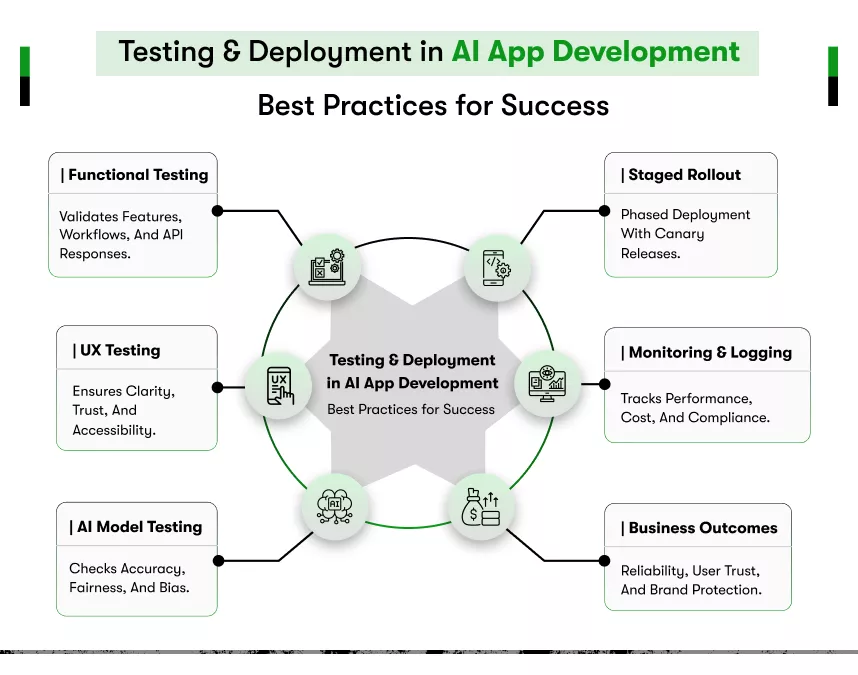
Functional Testing
Functional testing verifies that every feature of the app works as designed. Teams check workflows end-to-end, validate data pipelines, and confirm API responses.
For AI-specific features, tests ensure that predictions integrate correctly with business logic, such as risk scoring in finance or medical alerts in healthcare.
UX Testing
AI apps succeed only if users understand and trust them. UX testing confirms that interfaces present outputs clearly, show confidence scores where relevant, and offer fallback options when predictions are uncertain.
When planning AI for app development, usability sessions and accessibility checks ensure that diverse users, including those with disabilities, can interact smoothly with the app.
AI Model Testing
AI models require deeper validation than standard software components. Teams test for accuracy, precision, recall, and fairness across different data groups. Bias detection tools identify unintended discrimination, while adversarial testing uncovers vulnerabilities.
Continuous evaluation ensures models adapt when new data arrives, reducing drift and maintaining performance.
Staged Rollout
Deployment should never follow a big bang approach because it increases the risk of failure and customer dissatisfaction. A phased rollout strategy, starting with canary releases and A/B testing, lets teams measure performance with small user groups first.
Early feedback reveals usability gaps, unexpected errors, or performance bottlenecks before scaling to the entire audience.
Monitoring and Logging
Once live, monitoring systems track predictions, latency, error rates, and cost metrics in real time. Logging every request and response provides an audit trail, critical for compliance in regulated industries like banking and healthcare.
Teams that build AI chatbots app also benefit from proactive monitoring, as it ensures anomalies are detected before customers experience issues.
Testing and deployment are where AI moves from theory to production. Robust validation, careful rollout, and disciplined monitoring ensure the app delivers consistent value under real-world conditions.
Enterprises that invest in this stage safeguard trust, reduce risk, and set the foundation for AI applications that scale successfully.

How Much Does AI App Development Cost and How Long Does It Take?
The cost and timeline of AI app development vary based on product scope, team expertise, and technical complexity. MVPs validate ideas faster at lower budgets, while full-scale products require longer timelines, advanced AI features, stronger infrastructure, and higher investment.
Cost & Timeline by Development Area
| Development Area | Scope of Work | Timeline | Cost (USD) |
| Backend Development | Data pipelines, model serving, APIs, security | 6–16 weeks | $20,000–$80,000 |
| Frontend Development | UI, dashboards, explainability, cross-platform | 6–12 weeks | $15,000–$60,000 |
| AI / ML Development | Model selection, training, validation, deployment | 8–20 weeks | $30,000–$120,000 |
| API Integration | CRM/ERP connections, webhooks, auth, middleware | 4–10 weeks | $10,000–$40,000 |
| Testing & QA | Functional, UX, model testing, bias checks | 4–8 weeks | $10,000–$30,000 |
| Deployment & Monitoring | Rollout, logging, alerts, scaling | 3–6 weeks | $10,000–$25,000 |
Why these bands: They align to total project ranges reported across multiple 2026 guides and AI MVP posts; the per-area bands reflect common budget allocation patterns used by vendors and consultancies. See sources below for the total figures they publish.
Cost & Timeline by App Complexity (source-based)
AI app development costs and timelines vary based on scope, complexity, and infrastructure choices. MVPs allow businesses to validate ideas quickly at lower budgets, while full products require deeper investment in backend, frontend, AI modeling, and compliance.
For enterprises, understanding the cost to develop an AI app helps align budgets with business goals and ensures smarter allocation of resources. Companies that plan realistically for both cost and time avoid surprises, control risks, and achieve faster returns from AI app development.

What Are the Key Challenges in AI App Development and How to Overcome Them?
AI app development offers huge potential, but many projects fail because leaders underestimate the challenges. Problems like biased models, overfitting, or poor UX can derail even the best-funded initiatives. Understanding these pitfalls and knowing how to solve them helps businesses succeed with confidence.
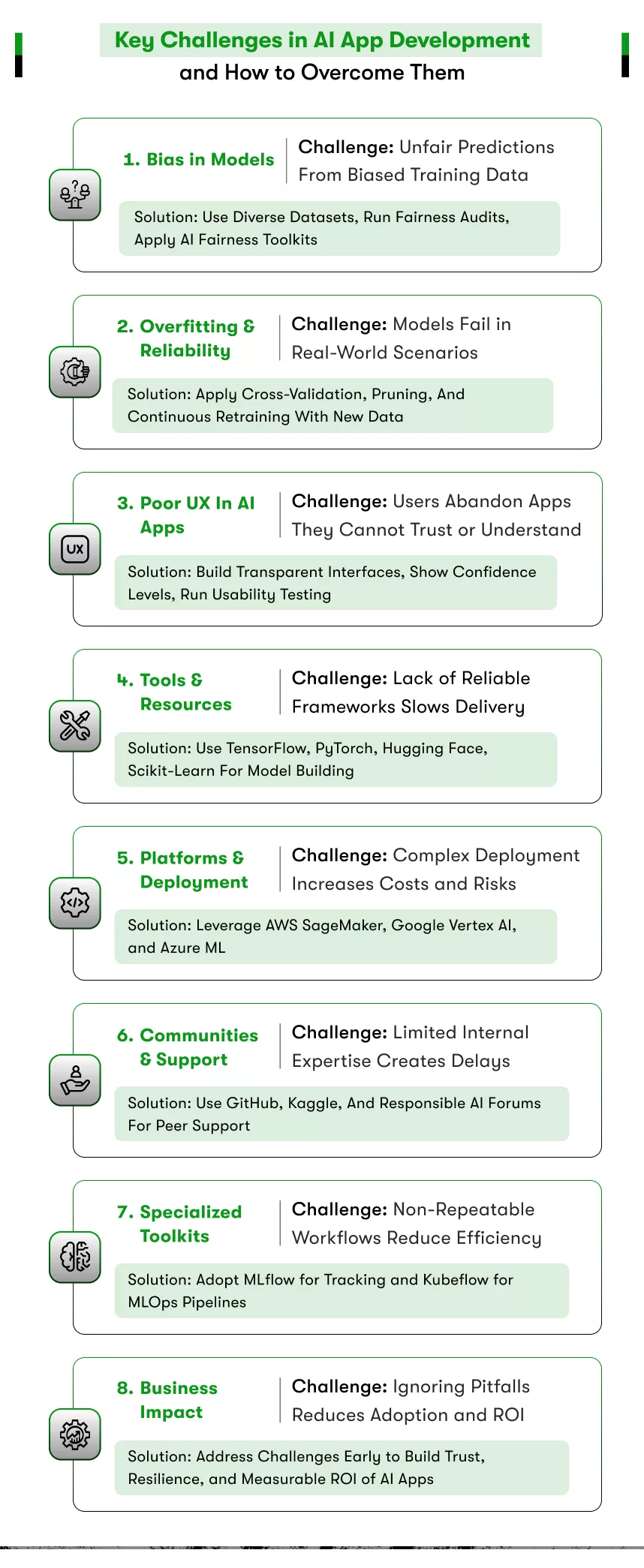
Bias in Models
Challenge: Bias in training data can lead to unfair predictions. In finance, this could mean rejecting qualified loan applicants. In healthcare, it may result in misdiagnosis.
Solution: Use diverse, representative datasets. Regularly audit outputs for bias. Adopt open libraries like Fairlearn or IBM AI Fairness 360. Communities such as Google’s Responsible AI forums provide guidance on mitigation strategies. This is a critical step in AI in mobile application development, where apps directly impact end users.
Overfitting and Model Reliability
Challenge: Overfitting happens when models perform well on training data but fail in the real world. This creates poor user trust and inconsistent outcomes.
Solution: Apply cross-validation, pruning, and dropout methods. Continuously retrain with new data to reduce drift. Frameworks such as TensorFlow and PyTorch include built-in tools to detect and reduce overfitting, supporting teams learning how to develop an AI app without wasting resources.
Poor UX in AI Apps
Challenge: Even accurate models fail if users cannot understand or trust predictions. A confusing interface or lack of transparency causes frustration and abandonment.
Solution: Build clear interfaces that show confidence levels, explanations, and fallback options. Conduct usability testing early. Communities like UX for AI or platforms such as Figma offer resources for designing human-friendly interfaces that align with the goals of AI app development.
Tools and Resources to Overcome Challenges
- Libraries: TensorFlow, PyTorch, Scikit-learn, Hugging Face for model building and tuning.
- Platforms: AWS SageMaker, Google Vertex AI, and Azure ML simplify deployment and monitoring.
- Communities: GitHub, Kaggle, and specialized forums provide code, datasets, and peer support.
- Specialized Toolkits: For teams figuring out how to develop AI based app solutions, tools like MLflow for experiment tracking or Kubeflow for MLOps ensure repeatable, reliable workflows.
Challenges like bias, overfitting, and poor UX can undermine AI adoption if ignored. With the right tools, resources, and governance, enterprises can overcome these pitfalls and build applications that users trust. Addressing these issues upfront not only strengthens delivery but also improves the measurable ROI of AI apps. Companies that prepare for these challenges early make their AI app development projects more resilient, predictable, and impactful.
Conclusion: AI App Development That Works for Business
AI app development gives companies practical ways to save money, make decisions faster, and serve customers better. Success comes when the work is planned properly, tested carefully, and supported by a team that knows enterprise needs.
Projects often face hurdles such as bias, weak integration, or compliance demands. These can be addressed with the right expertise, giving enterprises the confidence to scale their ideas into market-ready solutions.
Kody Technolab has built its reputation by guiding enterprises through complex AI journeys. Our expertise covers everything from backend engineering and frontend design to model development and compliance.
We don’t stop at deployment; we support continuous improvement so your AI apps stay effective and reliable in changing markets. As a generative AI development company, we work closely with leaders to align technology decisions with business goals and deliver measurable outcomes.
FAQs on AI App Development
1. How much does AI app development cost?
AI app development typically costs between $25,000 and $150,000 depending on complexity, features, and team expertise. Simple MVPs cost less, while advanced, enterprise-grade solutions with custom AI models and integrations cost significantly more.
Costs are driven by backend, frontend, AI modeling, integrations, and compliance. Enterprises should request a custom quote aligned with their goals.
2. How long does it take to build an AI app?
Building an AI app takes 3–12 months depending on scope. MVPs launch faster, while complex applications with custom AI and enterprise integrations need longer development and testing cycles.
Many companies choose to hire AI developers to accelerate delivery, ensure quality, and manage specialized tasks like model training. Timelines include planning, design, backend, frontend, model training, testing, an
3. What are the benefits of AI app development for my business?
AI app development improves efficiency, automates decisions, personalizes customer experiences, and reduces operational costs. Businesses see stronger revenue growth and better risk management through data-driven insights.
Industries like fintech, healthcare, logistics, and retail already benefit from AI-enhanced apps in fraud detection, diagnosis, optimization, and personalization.
4. How secure is AI app development?
AI apps can be highly secure when built with strong encryption, data governance, access control, and monitoring.
Compliance with standards like GDPR, HIPAA, or PCI ensures both data safety and regulatory approval.
5. Do AI apps need ongoing maintenance after launch?
Yes. AI apps require continuous monitoring, retraining, and updates to prevent performance drift.
Ongoing work ensures predictions stay accurate, systems remain secure, and the app adapts to changing business requirements or regulations.
6. Can AI be added to an existing app?
Yes, AI can be integrated into existing apps through APIs or custom modules.
Many companies begin with chatbots, recommendation engines, or fraud detection. Expanding AI in app development later enables deeper features without the need to rebuild the entire application.
7. What skills or team members are needed for AI app development?
AI for app development requires data scientists, ML engineers, backend developers, frontend developers, and QA testers.
Smaller teams often rely on managed AI platforms such as AWS SageMaker or Google Vertex AI to reduce staffing needs and accelerate delivery.
8. How do I protect my data during AI app development?
Strong governance, encryption, anonymization, and secure pipelines protect sensitive information.
In AI mobile app development, especially for healthcare or finance, compliance with GDPR, HIPAA, or PCI-DSS frameworks is essential from the start to ensure user trust and regulatory approval.
9. Can AI apps run offline?
Yes, lightweight AI models can run offline using edge computing.
AI in mobile application development often uses on-device processing to provide fast responses and maintain privacy, while resource-heavy training tasks still require cloud-based infrastructure for scalability.
10. How do I measure ROI for AI app development?
ROI is measured through efficiency gains, cost savings, revenue growth, and improved engagement. Businesses that define clear metrics, such as reduced fraud losses or higher conversions, understand early how to develop an AI app that delivers measurable returns.
11. Which industries get the fastest ROI from AI apps?
Industries like fintech, retail, and logistics often see the quickest results.
AI app development supports use cases such as fraud detection, route optimization, and product recommendations, which deliver tangible financial returns within months of launch.

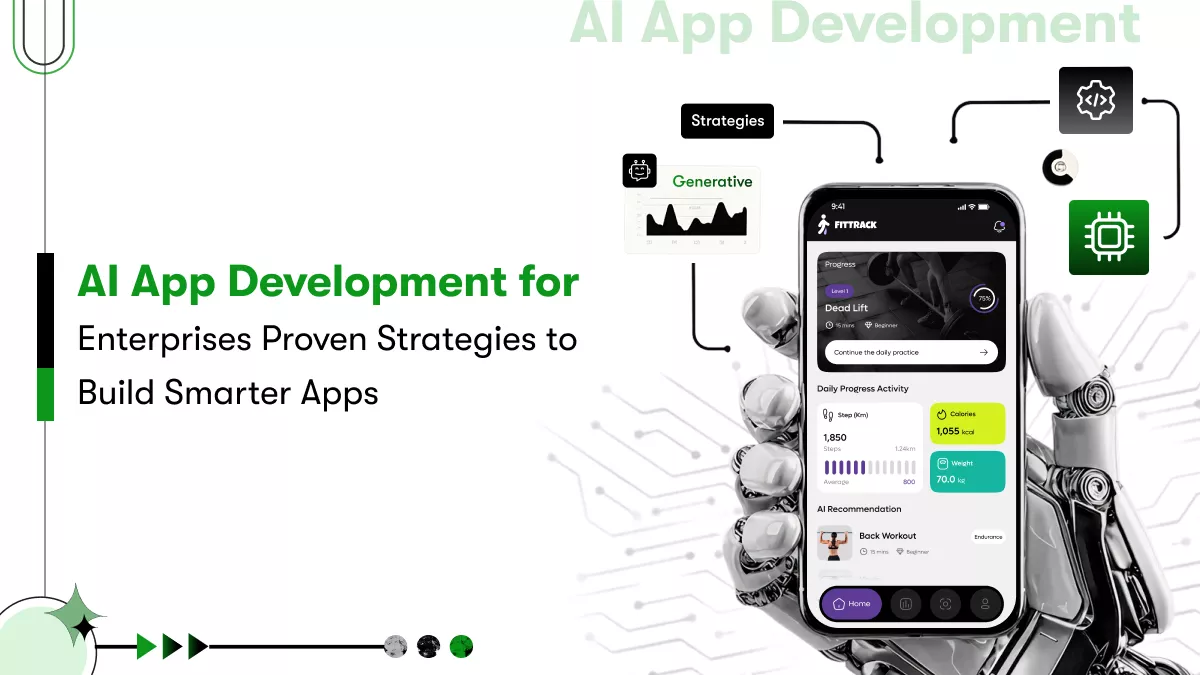
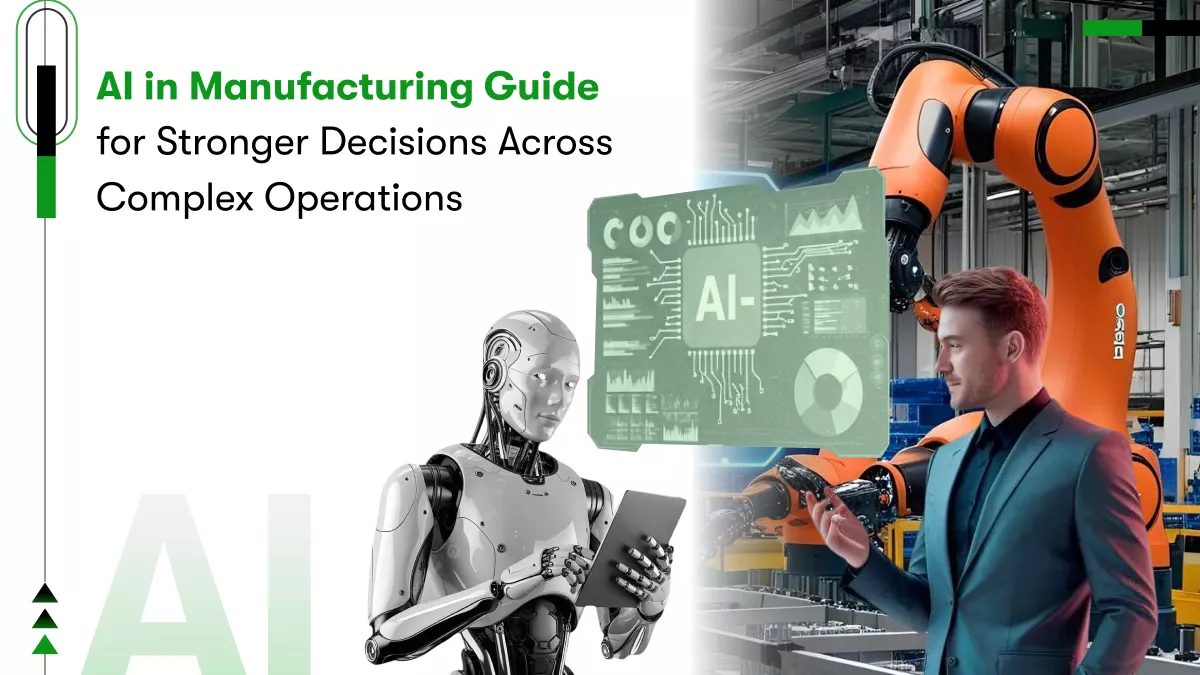
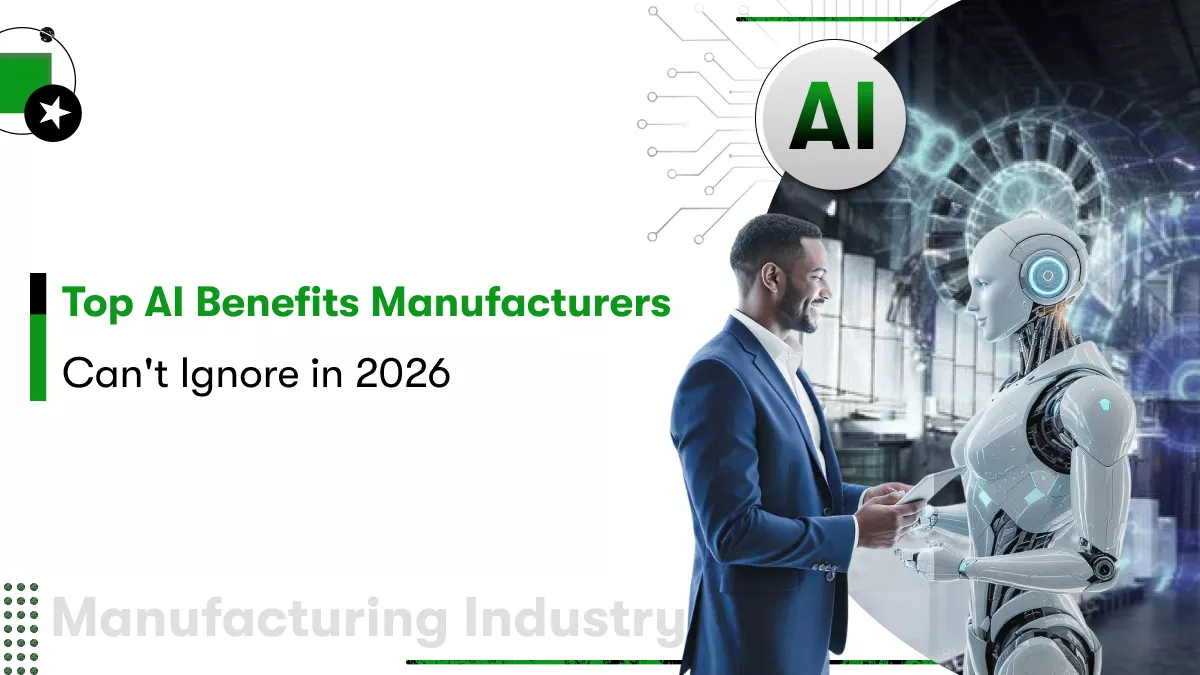
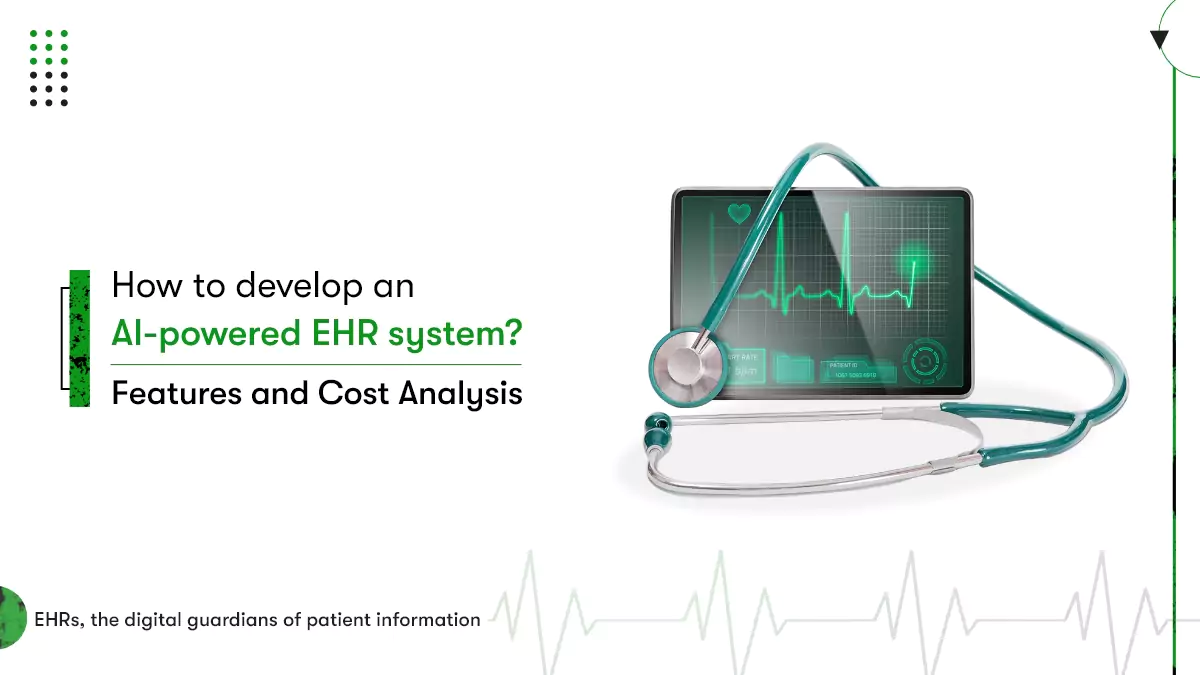








 Contact Information
Contact Information